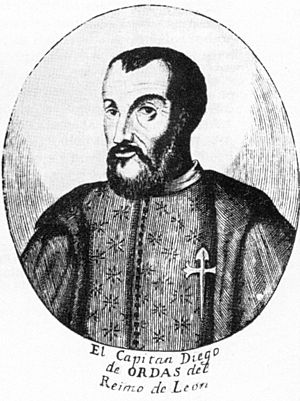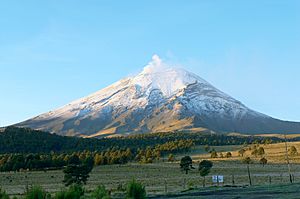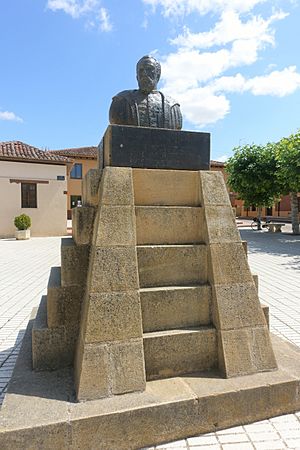Diego de Ordaz facts for kids
Diego de Ordaz (born in 1480 in Castroverde de Campos, Spain, died in 1532 in the Atlantic Ocean) was a brave Spanish explorer and soldier. He played an important role during the time when Europeans first explored and settled in the Americas. Ordaz is best known for traveling with Hernán Cortés during the Spanish conquest of Mexico. He also explored parts of South America, looking for a legendary golden kingdom called El Dorado.
Contents
Early Adventures
Diego de Ordaz came to Cuba when he was young. He worked for Diego Velázquez de Cuéllar, who was the governor of Cuba. Ordaz took part in some of the first trips to explore new lands in places like Colombia and Panama.
Exploring Mexico with Cortés
Captain De Ordaz joined Hernán Cortés on his big trip to conquer the Mexican mainland. He was recognized for helping the Spanish win a battle against the Aztecs near the Río Grijalva in Tabasco on March 25, 1519. This victory was very important for the Spanish.
Climbing Popocatépetl
Diego de Ordaz and two friends were the first Europeans to climb to the top of the huge volcano called Popocatépetl. This amazing feat greatly impressed the native allies who were with Cortés. To honor Ordaz's bravery, the emperor Charles V gave him a special coat-of-arms on October 22, 1525. This coat-of-arms showed a picture of the volcano.
Conquest of Tenochtitlan
Captain De Ordaz also helped in the Spanish conquest of Tenochtitlan, which was the capital city of the Aztecs. Before the final victory, the Spanish had to escape from the city one night. This event is known as La Noche Triste, or "the sad night." During this escape, De Ordaz was wounded.
After Mexico was conquered, De Ordaz explored new areas like Oaxaca and Veracruz. He also sailed along the Coatzacoalcos River. In 1521, he was sent back to Spain. His job was to tell the Spanish court the story of the conquest of Mexico. He also worked to get Cortés the important title of Governor and General Captain of New Spain.
Searching for El Dorado
Captain De Ordaz returned to North America around 1525. In 1529, he was given land called El Peñón de los Baños, which was near Mexico City.
He went back to Spain again and was made "Governor of the Islands in the Rio Marañon." This was the area where the Amazon River meets the ocean. This river had been found by Vicente Yáñez Pinzón in 1500, but it had not been explored much since then.
Journey on the Orinoco River
Ordaz could not find the Amazon River. Instead, he traveled more than 1,000 miles up the Orinoco River. During his travels, he heard stories from the native people about a rich kingdom called Meta. This kingdom was said to be like the legendary El Dorado. It was supposedly located beyond a mountain on the left side of the Orinoco River. After he failed to find this golden kingdom, he decided to return to Spain. Sadly, he died in 1532 while sailing across the Atlantic Ocean.
Legacy
In 1952, a new city was planned and built in Venezuela. It was named Puerto Ordaz and is located on the banks of the Orinoco River. Today, it is one of Venezuela's most important cities.
Diego de Ordaz was also a main character in an old historical novel called Jicoténcal. This book was published in 1826.
See also
 In Spanish: Diego de Ordás para niños
In Spanish: Diego de Ordás para niños




